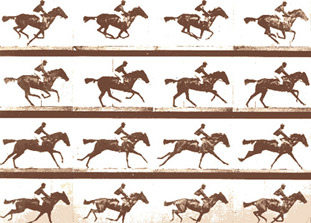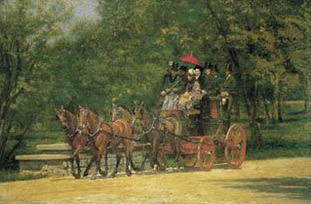 |
When Muybridge’s camera arrested the motions of a galloping horse in 1878, it proved that thousands of years of art had been sorely mistaken. Horses did indeed, as some had conjectured, have all four legs off the ground at one time, not before and behind the body like a rocking horse, as artists had always showed them, but gathered under the belly. This bit of news was shocking. Muybridge proved that what people thought they knew because it was what their eyes saw was not true at all.
|
1978 © "Running Horse" Eadweard Muybridge |
A leading art magazine remarked, “To the great surprise of photographers and of all those who saw these prints, the attitudes are, for the most part, not only disgraceful but of a false and impossible appearance.” Horses weren’t supposed to look like Muybridge’s photographs. They were supposed to look the way painters had always shown them. Muybridge’s photographs revealed that perception depends heavily on representation; we see what we have seen before, what we have been taught to believe, what we think we know. Photography was already changing the nature of perception.
The pictures provoked an artistic quarrel between knowledge and vision.
 |
1879© "The Fairman Rogers" Thomas Eakins |
When Thomas Eakins painted a carriage pulled by four horses, people objected that the wheel didn’t look like it was moving, because no one could see the spokes of a moving wheel clearly. The photographs depicted facts so perfectly that realism no longer looked very real, so maybe the camera wasn’t so truthful after all. Rodin said, “It is the artist who is truthful and it is photography which lies, for in reality time does not stop.” Rodin, among others, thought it preferable for art to look truthful to experience than to be truthful to fact, but Muybridge’s achievement had driven a wedge into the very definition of truth, long before we decided that photographs were liars anyway. |
IT HAPPENED ONE NIGHT
Muybridge devised a way to project his still images so rapidly that it looked like the horse was running across the screen; he has been called the father of the motion picture. Movies and movie stills always worked together, and at least once they had a great and even a measurable impact. Clark Gable and Claudette Colbert both won Oscars for their starring roles in the 1934 comedy, It Happened One Night. Colbert played a rebellious heiress running away from her rich father, Gable a reporter who joins her because he hopes to get a story. One night they’re forced by lack of money to share a motel room, but in this more delicate era, Gable divides the room by hanging a blanket on a rope.
Both of them stubbornly insist on the same side of the curtain. She won’t budge, so Gable decides to give her a lesson in how a man gets undressed. First he takes off his jacket – he’s demonstrating -- then his tie, then his shirt. Then he takes off his shoes, his socks. When he’s wearing nothing but trousers and doesn’t show any signs of stopping, she zips as fast as she can to the other side of the curtain.
Gable became a major star and sex symbol with this movie. Women swooned over him, so American men copied everything about him. Men who had been clean shaven suddenly sported moustaches. They went out and bought the kind of jacket, sweater and hat he wore, and they wore their trench coats as he did, with the belts tied rather than buckled. He simply set men’s fashions.
In 1934, American men all wore undershirts, but when Gable took off his shirt in the motel, he wasn’t wearing one. If Gable didn’t wear an undershirt, then obviously undershirts were not truly masculine. Men stopped wearing them. Sales of undershirts reportedly plunged by 75 percent. Undershirt manufacturers complained to Hollywood that they were going bankrupt, at a time when the country was in a deep Depression. So in 1939, Hollywood made a movie in which Gable took off his shirt and was revealed to be wearing – you can probably guess -- an undershirt.
 |
That movie was Idiot's delight, with Gable and Norma Shearer. The movie wasn't that good, so I'm not sure that the undershirt industry entirely recovered.
Cinema and fan magazines and the new photographic magazines like Life in the 1930s heightened photography’s power to create celebrity, influence fashion, fads, and behavior, and make a dent in the nation’s pocketbook.
News photographs also got a big boost from the increasing dominance of the visual media. The Vietnam war has been called the first television war, but it is recalled all over the globe in the form of still images rather than television clips.

